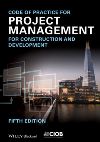Code of practice for project management Fifth edition
NB In May 2022, CIOB published a 6th edition of the code of practice. For more information see: Sixth edition of the Code of Practice for Project Management.
In 1991 the Chartered Institute of Building (CIOB) initiated a multi-institute task force which published the Code of Practice for Project Management for Construction and Development in 1992. It set out for the first time a comprehensive specification for the role of project manager.
The second edition, published in 1996, included new information about public procurement, partnering and risk. Changes included in the third edition, published in 2002, reflected the core stages of the project management processes and the fourth edition, published in 2010, absorbed a range of new themes emerging in the industry.
The 5th Edition, published in September 2014 was completely overhauled to make it more contemporary and was updated and restructured to reflect the new challenges face by the industry. It was prepared in collaboration with a number of key professional bodies.
According to CIOB, good project management relies on balancing time, quality and cost in relation to building functionality and requirements for sustainability. The principles of strategic planning, detailed programming and monitoring, resource allocation and effective risk management, are covered by the guide. The integration of Building Information Modelling (BIM) is also featured. In addition, the impact of trends and developments such as the internationalisation of construction projects and the drive for sustainability are discussed.
Chris Blythe, CIOB chief executive said; “I am pleased to see that the 5th edition of this document is being published at a time where the built environment is gathering great momentum, with a number of high profile projects as well as the resurgence of the housing sector, where construction project management, as a professional service and discipline, is at the forefront of ensuring delivery management.
“The Code of Practice will retain its position as the primary source of guidance on the principles and practice of construction project management irrespective of the size, nature or complexity of the project.”
David Woolven, Chair of the CIOB Working Group said, “This publication is a result of many hours of debate, discussion and re-drafting and a lot of effort has gone into the information contained within this edition. The result I believe has been a truly impressive and highly authoritative guide to the current practice of construction project management, for those who are either involved or likely to be involved in managing projects, irrespective of their previous experience and knowledge in built environment.”
Table of contents:
- Introduction.
- Inception.
- Feasibility.
- Strategy.
- Pre-construction.
- Construction.
- Testing and commissioning.
- Completion, handover and operation.
- Post-completion review and in use.
- Glossary.
- Bibliography.
NB: On 26 September 2016, CIOB launched its first Code of Practice for Programme Management. Programme management is the process of managing several related projects, often with the intention of improving an organisation’s performance. The code sets out the requirements for effective programme management, ensuring systematic quality control and documentation through governance arrangements and explains the benefits of managing a number of connected projects as a programme.
--CIOB
[edit] Related articles on Designing Buildings
- A solution to handle large and complex construction projects: Interface Management.
- Association for Project Management APM
- Business administration.
- Code of practice for programme management.
- CIOB.
- Conflict of interest.
- Design management.
- Microsoft's six ways to supercharge project management.
- Monte Carlo simulation.
- Preliminary business case.
- Project execution plan.
- Projectisation.
- Project management.
- Risk management.
- Sixth edition of the Code of Practice for Project Management.
- Value management.
Featured articles and news
RTPI leader to become new CIOB Chief Executive Officer
Dr Victoria Hills MRTPI, FICE to take over after Caroline Gumble’s departure.
Social and affordable housing, a long term plan for delivery
The “Delivering a Decade of Renewal for Social and Affordable Housing” strategy sets out future path.
A change to adoptive architecture
Effects of global weather warming on architectural detailing, material choice and human interaction.
The proposed publicly owned and backed subsidiary of Homes England, to facilitate new homes.
How big is the problem and what can we do to mitigate the effects?
Overheating guidance and tools for building designers
A number of cool guides to help with the heat.
The UK's Modern Industrial Strategy: A 10 year plan
Previous consultation criticism, current key elements and general support with some persisting reservations.
Building Safety Regulator reforms
New roles, new staff and a new fast track service pave the way for a single construction regulator.
Architectural Technologist CPDs and Communications
CIAT CPD… and how you can do it!
Cooling centres and cool spaces
Managing extreme heat in cities by directing the public to places for heat stress relief and water sources.
Winter gardens: A brief history and warm variations
Extending the season with glass in different forms and terms.
Restoring Great Yarmouth's Winter Gardens
Transforming one of the least sustainable constructions imaginable.
Construction Skills Mission Board launch sector drive
Newly formed government and industry collaboration set strategy for recruiting an additional 100,000 construction workers a year.
New Architects Code comes into effect in September 2025
ARB Architects Code of Conduct and Practice available with ongoing consultation regarding guidance.
Welsh Skills Body (Medr) launches ambitious plan
The new skills body brings together funding and regulation of tertiary education and research for the devolved nation.
Paul Gandy FCIOB announced as next CIOB President
Former Tilbury Douglas CEO takes helm.
UK Infrastructure: A 10 Year Strategy. In brief with reactions
With the National Infrastructure and Service Transformation Authority (NISTA).
























